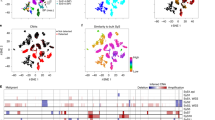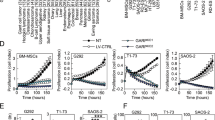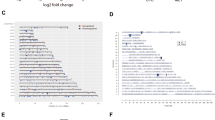Abstract
Synovial sarcoma accounts for almost 10% of all soft tissue sarcomas, and its prognosis is poor with 5-year survival rates at 36%. Thus, new treatments and therapeutic targets for synovial sarcoma are required. Tumor-initiating cells have been defined by the ability for self-renewal and multipotent differentiation, and they exhibit higher tumorigenic capacity, chemoresistance and radiation resistance, expecting to be a new therapeutic target. In synovial sarcoma, the presence of such stemness remains largely unclear; thus, we analyzed whether synovial sarcoma possessed tumor-initiating cells and explored specific markers, and we discovered that synovial sarcoma cell lines possessed heterogeneity by way of containing a sphere-forming subpopulation highly expressing NANOG, OCT4 and SOX2. By expression microarray analysis, CXCR4 was identified to be highly expressed in the sphere subpopulation and correlated with stem-cell-associated markers. Inhibition of CXCR4 suppressed the cell proliferation of synovial sarcoma cell lines in vitro. The tumor-initiating ability of CXCR4-positive cells was demonstrated by xenograft propagation assay. CXCR4-positive cells showed higher tumorigenicity than negative ones and possessed both self-renewal and multipotent differentiation ability. Immunohistochemical analysis of 39 specimens of synovial sarcoma patients revealed that CXCR4 strongly correlated with poor prognosis of synovial sarcoma. Thus, we conclude that CXCR4 is the marker of synovial sarcoma-initiating cells, a new biomarker for prognosis and a new potential therapeutic target.
This is a preview of subscription content, access via your institution
Access options
Subscribe to this journal
Receive 50 print issues and online access
$259.00 per year
only $5.18 per issue
Buy this article
- Purchase on Springer Link
- Instant access to full article PDF
Prices may be subject to local taxes which are calculated during checkout






Similar content being viewed by others
References
Haldar M, Randall RL, Capecchi MR . Synovial sarcoma: from genetics to genetic-based animal modeling. Clin Orthop Relat Res 2008; 466: 2156–2167.
Eid JE, Kung AL, Scully R, Livingston DM . p300 interacts with the nuclear proto-oncoprotein SYT as part of the active control of cell adhesion. Cell 2000; 102: 839–848.
Ito T, Ouchida M, Ito S, Jitsumori Y, Morimoto Y, Ozaki T et al. SYT, a partner of SYT-SSX oncoprotein in synovial sarcomas, interacts with mSin3A, a component of histone deacetylase complex. Lab Invest 2004; 84: 1484–1490.
Nagai M, Tanaka S, Tsuda M, Endo S, Kato H, Sonobe H et al. Analysis of transforming activity of human synovial sarcoma-associated chimeric protein SYT-SSX1 bound to chromatin remodeling factor hBRM/hSNF2 alpha. Proc Natl Acad Sci USA 2001; 98: 3843–3848.
Tsuda M, Watanabe T, Seki T, Kimura T, Sawa H, Minami A et al. Induction of p21(WAF1/CIP1) by human synovial sarcoma-associated chimeric oncoprotein SYT-SSX1. Oncogene 2005; 24: 7984–7990.
Watanabe T, Tsuda M, Makino Y, Ichihara S, Sawa H, Minami A et al. Adaptor molecule Crk is required for sustained phosphorylation of Grb2-associated binder 1 and hepatocyte growth factor-induced cell motility of human synovial sarcoma cell lines. Mol Cancer Res 2006; 4: 499–510.
Watanabe T, Tsuda M, Makino Y, Konstantinou T, Nishihara H, Majima T et al. Crk adaptor protein-induced phosphorylation of Gab1 on tyrosine 307 via Src is important for organization of focal adhesions and enhanced cell migration. Cell Res 2009; 19: 638–650.
Minami Y, Kohsaka S, Tsuda M, Yachi K, Hatori N, Tanino M et al. SS18-SSX-regulated miR-17 promotes tumor growth of synovial sarcoma by inhibiting p21WAF1/CIP1. Cancer Sci 2014; 105: 1152–1159.
Jordan CT, Guzman ML, Noble M . Cancer stem cells. N Engl J Med 2006; 355: 1253–1261.
Mohseny AB, Hogendoorn PC . Concise review: mesenchymal tumors: when stem cells go mad. Stem Cells 2011; 29: 397–403.
Adhikari AS, Agarwal N, Wood BM, Porretta C, Ruiz B, Pochampally RR et al. CD117 and Stro-1 identify osteosarcoma tumor-initiating cells associated with metastasis and drug resistance. Cancer Res 2010; 70: 4602–4612.
Tirino V, Desiderio V, Paino F, De Rosa A, Papaccio F, Fazioli F et al. Human primary bone sarcomas contain CD133+ cancer stem cells displaying high tumorigenicity in vivo. FASEB J 2011; 25: 2022–2030.
Suva ML, Riggi N, Stehle JC, Baumer K, Tercier S, Joseph JM et al. Identification of cancer stem cells in Ewing's sarcoma. Cancer Res 2009; 69: 1776–1781.
Hirotsu M, Setoguchi T, Matsunoshita Y, Sasaki H, Nagao H, Gao H et al. Tumour formation by single fibroblast growth factor receptor 3-positive rhabdomyosarcoma-initiating cells. Br J Cancer 2009; 101: 2030–2037.
Murase M, Kano M, Tsukahara T, Takahashi A, Torigoe T, Kawaguchi S et al. Side population cells have the characteristics of cancer stem-like cells/cancer-initiating cells in bone sarcomas. Br J Cancer 2009; 101: 1425–1432.
Naka N, Takenaka S, Araki N, Miwa T, Hashimoto N, Yoshioka K et al. Synovial sarcoma is a stem cell malignancy. Stem Cells 2010; 28: 1119–1131.
Perani M, Antonson P, Hamoudi R, Ingram CJ, Cooper CS, Garrett MD et al. The proto-oncoprotein SYT interacts with SYT-interacting protein/co-activator activator (SIP/CoAA), a human nuclear receptor co-activator with similarity to EWS and TLS/FUS family of proteins. J Biol Chem 2005; 280: 42863–42876.
Kadoch C, Crabtree GR . Reversible disruption of mSWI/SNF (BAF) complexes by the SS18-SSX oncogenic fusion in synovial sarcoma. Cell 2013; 153: 71–85.
Su L, Sampaio AV, Jones KB, Pacheco M, Goytain A, Lin S et al. Deconstruction of the SS18-SSX fusion oncoprotein complex: insights into disease etiology and therapeutics. Cancer Cell 2012; 21: 333–347.
Kimura T, Wang L, Tabu K, Nishihara H, Mashita Y, Kikuchi N et al. CD133 negatively regulates tumorigenicity via AKT pathway in synovial sarcoma. Cancer Invest 2012; 30: 390–397.
Liu A, Feng B, Gu W, Cheng X, Tong T, Zhang H et al. The CD133+ subpopulation of the SW982 human synovial sarcoma cell line exhibits cancer stem-like characteristics. Int J Oncol 2013; 42: 1399–1407.
Ratajczak MZ, Zuba-Surma E, Kucia M, Reca R, Wojakowski W, Ratajczak J . The pleiotropic effects of the SDF-1-CXCR4 axis in organogenesis, regeneration and tumorigenesis. Leukemia 2006; 20: 1915–1924.
Haldar M, Hancock JD, Coffin CM, Lessnick SL, Capecchi MR . A conditional mouse model of synovial sarcoma: insights into a myogenic origin. Cancer Cell 2007; 11: 375–388.
Chapman MR, Balakrishnan KR, Li J, Conboy MJ, Huang H, Mohanty SK et al. Sorting single satellite cells from individual myofibers reveals heterogeneity in cell-surface markers and myogenic capacity. Integr Biol (Camb) 2013; 5: 692–702.
Sherwood RI, Christensen JL, Conboy IM, Conboy MJ, Rando TA, Weissman IL et al. Isolation of adult mouse myogenic progenitors: functional heterogeneity of cells within and engrafting skeletal muscle. Cell 2004; 119: 543–554.
Wynn RF, Hart CA, Corradi-Perini C, O'Neill L, Evans CA, Wraith JE et al. A small proportion of mesenchymal stem cells strongly expresses functionally active CXCR4 receptor capable of promoting migration to bone marrow. Blood 2004; 104: 2643–2645.
Geminder H, Sagi-Assif O, Goldberg L, Meshel T, Rechavi G, Witz IP et al. A possible role for CXCR4 and its ligand, the CXC chemokine stromal cell-derived factor-1, in the development of bone marrow metastases in neuroblastoma. J Immunol 2001; 167: 4747–4757.
Hall JM, Korach KS . Stromal cell-derived factor 1, a novel target of estrogen receptor action, mediates the mitogenic effects of estradiol in ovarian and breast cancer cells. Mol Endocrinol 2003; 17: 792–803.
Kaifi JT, Yekebas EF, Schurr P, Obonyo D, Wachowiak R, Busch P et al. Tumor-cell homing to lymph nodes and bone marrow and CXCR4 expression in esophageal cancer. J Natl Cancer Inst 2005; 97: 1840–1847.
Kim SY, Lee CH, Midura BV, Yeung C, Mendoza A, Hong SH et al. Inhibition of the CXCR4/CXCL12 chemokine pathway reduces the development of murine pulmonary metastases. Clin Exp Metastasis 2008; 25: 201–211.
Muller A, Homey B, Soto H, Ge N, Catron D, Buchanan ME et al. Involvement of chemokine receptors in breast cancer metastasis. Nature 2001; 410: 50–56.
Taichman RS, Cooper C, Keller ET, Pienta KJ, Taichman NS, McCauley LK . Use of the stromal cell-derived factor-1/CXCR4 pathway in prostate cancer metastasis to bone. Cancer Res 2002; 62: 1832–1837.
Zagzag D, Krishnamachary B, Yee H, Okuyama H, Chiriboga L, Ali MA et al. Stromal cell-derived factor-1alpha and CXCR4 expression in hemangioblastoma and clear cell-renal cell carcinoma: von Hippel-Lindau loss-of-function induces expression of a ligand and its receptor. Cancer Res 2005; 65: 6178–6188.
De Falco V, Guarino V, Avilla E, Castellone MD, Salerno P, Salvatore G et al. Biological role and potential therapeutic targeting of the chemokine receptor CXCR4 in undifferentiated thyroid cancer. Cancer Res 2007; 67: 11821–11829.
Hassan S, Buchanan M, Jahan K, Aguilar-Mahecha A, Gaboury L, Muller WJ et al. CXCR4 peptide antagonist inhibits primary breast tumor growth, metastasis and enhances the efficacy of anti-VEGF treatment or docetaxel in a transgenic mouse model. Int J Cancer 2011; 129: 225–232.
Huang EH, Singh B, Cristofanilli M, Gelovani J, Wei C, Vincent L et al. A CXCR4 antagonist CTCE-9908 inhibits primary tumor growth and metastasis of breast cancer. J Surg Res 2009; 155: 231–236.
Porvasnik S, Sakamoto N, Kusmartsev S, Eruslanov E, Kim WJ, Cao W et al. Effects of CXCR4 antagonist CTCE-9908 on prostate tumor growth. Prostate 2009; 69: 1460–1469.
Rubin JB, Kung AL, Klein RS, Chan JA, Sun Y, Schmidt K et al. A small-molecule antagonist of CXCR4 inhibits intracranial growth of primary brain tumors. Proc Natl Acad Sci USA 2003; 100: 13513–13518.
Smith MC, Luker KE, Garbow JR, Prior JL, Jackson E, Piwnica-Worms D et al. CXCR4 regulates growth of both primary and metastatic breast cancer. Cancer Res 2004; 64: 8604–8612.
Kim M, Koh YJ, Kim KE, Koh BI, Nam DH, Alitalo K et al. CXCR4 signaling regulates metastasis of chemoresistant melanoma cells by a lymphatic metastatic niche. Cancer Res 2010; 70: 10411–10421.
Kioi M, Vogel H, Schultz G, Hoffman RM, Harsh GR, Brown JM . Inhibition of vasculogenesis, but not angiogenesis, prevents the recurrence of glioblastoma after irradiation in mice. J Clin Invest 2010; 120: 694–705.
Saigusa S, Toiyama Y, Tanaka K, Yokoe T, Okugawa Y, Kawamoto A et al. Stromal CXCR4 and CXCL12 expression is associated with distant recurrence and poor prognosis in rectal cancer after chemoradiotherapy. Ann Surg Oncol 2010; 17: 2051–2058.
Xu L, Duda DG, di Tomaso E, Ancukiewicz M, Chung DC, Lauwers GY et al. Direct evidence that bevacizumab, an anti-VEGF antibody, up-regulates SDF1alpha, CXCR4, CXCL6, and neuropilin 1 in tumors from patients with rectal cancer. Cancer Res 2009; 69: 7905–7910.
Akashi T, Koizumi K, Tsuneyama K, Saiki I, Takano Y, Fuse H . Chemokine receptor CXCR4 expression and prognosis in patients with metastatic prostate cancer. Cancer Sci 2008; 99: 539–542.
Scala S, Ottaiano A, Ascierto PA, Cavalli M, Simeone E, Giuliano P et al. Expression of CXCR4 predicts poor prognosis in patients with malignant melanoma. Clin Cancer Res 2005; 11: 1835–1841.
Yopp AC, Shia J, Butte JM, Allen PJ, Fong Y, Jarnagin WR et al. CXCR4 expression predicts patient outcome and recurrence patterns after hepatic resection for colorectal liver metastases. Ann Surg Oncol 2012; 19: S339–S346.
Dubrovska A, Elliott J, Salamone RJ, Telegeev GD, Stakhovsky AE, Schepotin IB et al. CXCR4 expression in prostate cancer progenitor cells. PLoS One 2012; 7: e31226.
Dubrovska A, Hartung A, Bouchez LC, Walker JR, Reddy VA, Cho CY et al. CXCR4 activation maintains a stem cell population in tamoxifen-resistant breast cancer cells through AhR signalling. Br J Cancer 2012; 107: 43–52.
Jung MJ, Rho JK, Kim YM, Jung JE, Jin YB, Ko YG et al. Upregulation of CXCR4 is functionally crucial for maintenance of stemness in drug-resistant non-small cell lung cancer cells. Oncogene 2013; 32: 209–221.
Lee CG, Das B, Lin TL, Grimes C, Zhang X, Lavezzi T et al. A rare fraction of drug-resistant follicular lymphoma cancer stem cells interacts with follicular dendritic cells to maintain tumourigenic potential. Br J Haematol 2012; 158: 79–90.
Tan L, Sui X, Deng H, Ding M . Holoclone forming cells from pancreatic cancer cells enrich tumor initiating cells and represent a novel model for study of cancer stem cells. PLoS One 2011; 6: e23383.
Zheng X, Xie Q, Li S, Zhang W . CXCR4-positive subset of glioma is enriched for cancer stem cells. Oncol Res 2011; 19: 555–561.
Oda Y, Tateishi N, Matono H, Matsuura S, Yamamaoto H, Tamiya S et al. Chemokine receptor CXCR4 expression is correlated with VEGF expression and poor survival in soft-tissue sarcoma. Int J Cancer 2009; 124: 1852–1859.
Palmerini E, Benassi MS, Quattrini I, Pazzaglia L, Donati D, Benini S et al. Prognostic and predictive role of CXCR4, IGF-1R and Ezrin expression in localized synovial sarcoma: is chemotaxis important to tumor response? Orphanet J Rare Dis 2015; 10: 6.
Hirata K, Suzuki H, Imaeda H, Matsuzaki J, Tsugawa H, Nagano O et al. CD44 variant 9 expression in primary early gastric cancer as a predictive marker for recurrence. Br J Cancer 2013; 109: 379–386.
Kimura Y, Goi T, Nakazawa T, Hirono Y, Katayama K, Urano T et al. CD44variant exon 9 plays an important role in colon cancer initiating cells. Oncotarget 2013; 4: 785–791.
Olsson E, Honeth G, Bendahl PO, Saal LH, Gruvberger-Saal S, Ringner M et al. CD44 isoforms are heterogeneously expressed in breast cancer and correlate with tumor subtypes and cancer stem cell markers. BMC Cancer 2011; 11: 418.
Zeilstra J, Joosten SP, van Andel H, Tolg C, Berns A, Snoek M et al. Stem cell CD44v isoforms promote intestinal cancer formation in Apc(min) mice downstream of Wnt signaling. Oncogene 2014; 33: 665–670.
Acknowledgements
We thank Dr T Akagi for pCX4bleo vector. This work was supported in part by the Joint Usage/Research Program of Medical Research Institute, Tokyo Medical and Dental University (TMDU).
Author information
Authors and Affiliations
Corresponding authors
Ethics declarations
Competing interests
The authors declare no conflict of interest.
Additional information
Supplementary Information accompanies this paper on the Oncogene website
Rights and permissions
About this article
Cite this article
Kimura, T., Wang, L., Tabu, K. et al. Identification and analysis of CXCR4-positive synovial sarcoma-initiating cells. Oncogene 35, 3932–3943 (2016). https://doi.org/10.1038/onc.2015.461
Received:
Revised:
Accepted:
Published:
Issue Date:
DOI: https://doi.org/10.1038/onc.2015.461
This article is cited by
-
Synovial Sarcoma: A Complex Disease with Multifaceted Signaling and Epigenetic Landscapes
Current Oncology Reports (2020)
-
Synovial sarcoma of the brachial plexus – a rare tumor in a rare area: a case report
Journal of Medical Case Reports (2018)
-
Notch2 signal is required for the maintenance of canine hemangiosarcoma cancer stem cell-like cells
BMC Veterinary Research (2018)
-
Metastatic biomarkers in synovial sarcoma
Biomarker Research (2017)



